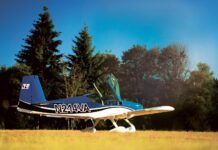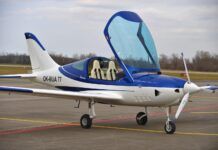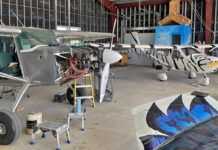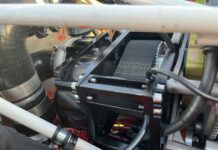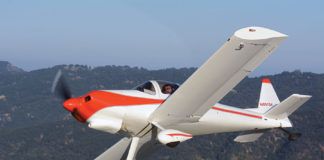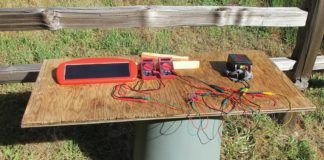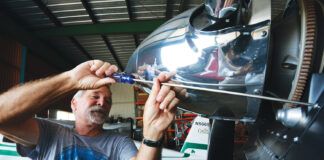Theoretical, that’s what it was. Not qualify for the Third Class medical? It was an interesting but not likely possibility. Light Sport Aircraft? The opposite: not interesting, in fact irrelevant. Then the roof caved in: “You’re unlikely to pass your FAA medical.” That was the Happy 59th Birthday message from my doctor during a routine physical.
Like many others in the same predicament, I’m sure, I panicked. I was 90% done building an RV-6/Mazda rotary on which I’d worked for eight years. The engine was mounted, the prop was in place, the intake and exhaust were built, and the radiators were almost finished. Now it’s a dead project? Worse and even further reaching: I have built my life around flying. I even moved my home to be on an airport. My emotions ran the gamut—despair, anger with the system.
So I came full circle. The Light Sport Aircraft option was initially rejected as being populated by quasi-toy aircraft, an impression I hadn’t bothered to align with any sense of fact. However, I didn’t want to give up flying, and to fly without a valid medical just wasn’t an option, so I was left with flying when another pilot could go with me. Or looking into LSA for myself.
Most of us know the main parameters of LSAs by now: two seats in a non-pressurized cabin, fixed gear (for landplanes), 120 knots maximum at sea level/maximum-continuous power, maximum stall speed (clean) of 45 knots, fixed or ground-adjustable prop. That leaves many options. Moreover, I had a wide selection of SLSA (ready to fly) versions, ELSA (Experimental LSA, partially or wholly kitbuilt) or Experimental/Amateur Built aircraft that meet the LSA performance and weight limitations. I scanned the annual KITPLANES® buyer’s guides and found 155 LSAs in the December 2006 issue and 71 plansbuilt LSAs in the January 2007 issue. There ought to be something I would like among over 200 airplanes!
Let the Shopping Begin
The variety is amazing! You can find autogyros, floatplanes, seaplanes, high wings and low, one, two and three wing, and nothing but wing, WW-I and WW-II fighters, sailplanes, motorgliders, fully enclosed cockpits or nothing-but-the-wing-enclosed airplanes. You can be launched by bungee, or go under your own power at 90 knots and 1000 fpm. You can rocket off the runway with a 4-second roll, climbing at 45° for as long as you like or just noodle your way up among the clouds. Now I had a new problem: choices.
Well, rather than picking something by looks or reputation, I made a list of my purely personal requirements: two people, side by side, 44-inch-wide, fully enclosed cockpit, comfortable headroom for a 6-foot-2 frame, baggage area large enough to hold two sets of sleeping bags, a tent and clothes for a week, 100 knot-cruise, 1000-fpm climb, a nosewheel (I love tailwheel, but I anticipated my wife wanting to use the plane), and less than 750 hours of build time. Everything was flexible if a design had an unusual advantage or appeal. And lest you think my engineering background controls all, I have to like the look of the plane (so much for my dispassionate approach). Still, it seemed a difficult set of requirements.
Surprisingly, I found several aircraft that come close to those criteria. The SeaRey, SeaStar, Jabiru J250, Dynamic WT9 and Mermaid are just a few of them. I found others that were attractive but, as too often happens, they were already out of business or out of my price range—even as a kit! Such is the volatility and range of the industry.
The Evaluations
For decisions like this, a second set of eyes is really important, so I took my buddy, Gene, along. I figured that with his experience in IFR, twin engines and warbirds, he’d have some pithy remarks—that and he’s 6-foot-7, so if he fit, anybody would.
Our first stop was to see a Jabiru J250. It’s a four-place airplane kit with two seats removed, a different wing and re-classified as LSA. The west coast rep, Jim McCormick, characterized it as “a 172 that got washed and then thrown into a too-hot dryer.” For comparison, we pulled it out alongside (make that under) my wife’s 172. It’s a pretty good assessment, actually.
Jim fit nicely, but he’s 5-foot-8, so I wasn’t feeling good about this. When Gene decided to try to sit in it, all I could think was, “This will be amusing.” I should have heeded the clue of an extra, removable back cushion on the left seat. Surprise! Gene declared it to have good headroom, and his feet were on the pedals! Reducing the foam from 3 inches to 1 inch of Visco-Elastic would give me a decent view out the side while being very comfortable.
The other big surprise was that removal of the rear seats created a lot of cargo space while keeping a big third door for loading. This is more like a sports car with decent baggage room. The J250 got a complete review in the February 2007 KITPLANES®, so I won’t go into the details, but it met my performance criteria when I went for a ride.
With this as encouragement, I went on to look at the Mermaid from Sport Aircraft Works. This gem is all aluminum held together by a whole lot of rivets, 90% of them already driven. What you see is essentially what you get in the kit. And it is roomier than the Jabiru! But a close consideration of these two aircraft prompted a phone call to the FSDO. Could a private pilot with a Third Class medical install additional seating in an ELSA and take additional passengers? The answer was yes, but the aircraft would have to be re-certified as Experimental/Amateur-Built. That means someone holding only Sport Pilot privileges could no longer fly it (not because it’s E/A-B, but because it would have more than two seats). Still, it might be a consideration for eventual sale of the airplane. Gene and I went on to look at other aircraft, both land-only and amphibians. Almost without exception, we were pleasantly surprised by the number of nice aircraft that fit under the LSA umbrella.
The Decision
Ultimately, the Jabiru J250 was my choice. It’s advertised as being able to be completed in 600 to 700 hours and comes with everything needed. I got a CD of the assembly instructions several weeks before the kit and read the first three chapters a half-dozen times with increasing enthusiasm. For instance, the very first chapter had me cutting slots that are marked on the tail. One of them is for the elevator trim cable. It’s marked with a fat, black, felt-tip pen, and it’s really obvious where it should be, so I thought I could hit the ground at a full run.
That first chapter also told me that I was to then permanently bond the bracketry to which the elevator controls attach. Right after that I’d set it up on the landing gear. This was great! It was quickly going to look like a real airplane.
Jabiru kits, like the engine, are manufactured in Australia, at what might be described as a leisurely rate. But luck was with me this time. Even though I didn’t have to put any money down until the kit was ready to go onboard the boat for the trip from Australia, someone else dropped out of the queue, and I was bumped up one slot. I was notified that my J250 kit had been shipped only six weeks after I had ordered it.
It came in through Long Beach, California, which is 500 miles south of where I live, and was then trucked north to the San Francisco region. While closer, that’s still about 140 miles one way. Enter another good friend, Frank. In addition to being a charter pilot on a Learjet, he has the biggest trailer in the neighborhood and a truck to pull it. He was willing to go with me to pick up the boxes, so bright and early on the first of June 2007, we were off to the Bay Area.
On the way down, I made several phone calls confirming that the kit had arrived at the warehouse (it beat us by about 2 hours) and that all of the paperwork was in place (it was being faxed as we drove). I sometimes cut it a bit tight.
Monster in a Box?
It was one strange looking package! “Wuzzat in the box?” asked the forklift operator. The reply of “an airplane kit” got a rejoinder to the effect that I must be nuts. You get used to this when explaining to non-builders what you’re doing, but it’s still amusing to see the expressions such a revelation elicits. The engine was in a little box on top, and that caused me some concern. Would it make it through a bouncing ride back home? I live up in the mountains over a winding road with a few rough spots. How many screws were holding it up there? Frank advised that we throw a strap over it.
The next morning I’m up at 4:30, feeling like a 12-year-old kid on Christmas morning. “C’mon Dad, get up! The sun’s almost up!” As I said, I can get enthusiastic. Some initial impressions: They must have found a deal on screws at the Jabiru factory because this thing is full of ’em! While I don’t think that I could have gotten away with turning the whole thing upside down and shaking it, it was pretty clear that my concerns for the stability of that engine box were a little over the top. Still, placing that extra strap over it was good for my security if not the engine’s.
I’d built about 100 square feet of shelving in the hangar, rolled my big workbench out onto the hangar floor and positioned the fuselage on padded sawhorses. The directions suggested using the sides of the crate to hold all of the parts that are shrink-wrapped onto cards. This is really a great idea. Several folks commented on the organization and were quite impressed with my skill. Wish I’d thought of it.
In the Cards
In putting up the cards, though, I got a clue that all might not be quite as perfect as it seemed. I found that some of the cards had an outline of each part, its part number and, at the top of the card, what this particular group was for. Wonderful! But some of the cards were missing this data, and some others had the parts taped on over the skin-pack material. The entire throttle system was packaged in a thin, oversized sandwich bag. The bag, though, was too small to contain all of the parts, so those that wouldn’t fit in the bag were held with tape around the opening. The sharper ones had poked several finger-sized holes in the bag, and there were a lot of smaller than finger-sized parts. I was left to wonder how many had disappeared through those holes.
As a former supplier quality engineer, it was my job to work with outside companies to improve their parts and how they were sent. As such, I felt like the proverbial fireman who jumps for his gear every time he hears a bell, even after retirement. Good ideas such as placing the parts on the cards are good ideas only if the implementation is consistent. I think Jabiru was on to a good idea here, but missed opportunities to make this concept really work for the builder.
Well, there was nothing to do but inventory everything as much as possible and hope that whatever was missing could be replaced without too much delay. Although some of the cards had stickers saying things like “oil cooler back-ordered” where the oil cooler should be, without a part number or outline on the card I had no idea what might not be so noted. And I certainly wouldn’t know the status of the throttle until I tried to assemble it. I realize that all kit manufacturers face similar challenges, but to come as far as Jabiru has with the concept and not close the loop is frustrating.
Jabiru’s advertising says that everything you need to build the airframe is included, even the cups and stir sticks. And while they were indeed there, a half-dozen of each wouldn’t cut it. (It’s a nice gesture to get you going, but builders with composites experience realize that you’ll tear through expendables such as cups, stir sticks, gloves and the like.) Sticks and spoons are one thing, but the hardener that goes with the resin was nowhere to be found. A call to Jim McCormick revealed that the $400 fee for the paperwork associated with shipping a hazardous material is collected whether for a gallon or a truckload. Because I picked up the crates at the shipper, he didn’t have the opportunity to add it to the crate from his stores. He told me that Aircraft Spruce has a tested hardener and then immediately got a small quantity delivered to me at no cost.
What I did order from Aircraft Spruce was an epoxy pump. It is, I think, an essential tool. After futzing around with scales for 20 minutes every time I needed a batch of epoxy, I was delighted to give the pump a stroke and have the right ratio without even opening the cans and messing up interim containers. Later in the project I would discover that it had a drawback; you can’t get that last ¾ inch of material to pump without sucking air and throwing the ratio off. At the end, I resorted to pumps in cans rather than buying the quantity needed to stay above the sucks-air level. However, the small-batch ability of the ratio pump probably saved the cost of wasted material even compared to the pump-in-can method.
The Horn of a Dilemma
That brings me back to that fat, black, felt-tip pen line on the tail that indicated the cut for the Teleflex elevator cable. I had cut the slot to the inside of the line. Had I read a bit further on, or even thought it through beforehand, I’d have realized that I should check to be sure that the cable would fit through the slot because bonding the ventral shroud makes it almost impossible to enlarge it should it be too narrow. As I am sure you’ve guessed, it was indeed too narrow. But with a bit of help from Gene, I managed to fit a round file onto a 30-inch-long shaft and, using a drill motor, was able to reach through from inside the tail to enlarge the slot. Consider that a bullet dodged.
However, it turned out that the alignment of that elevator bracket was a bit wrong. (Does it go to the left or to the right of the factory-supplied line?) I eventually had to cut it off and re-bond it. In the course of doing so, though, I had to question the wisdom of making such a critical component the first project for someone new to fiberglass. Yes, it’s easier with the fuselage upside down, but there are other areas such as cowling vents that could be fabricated without the risk of using this as the initial experience.
Worse, just after bonding the horn in place, the builder is instructed to bond a cover over it. The result is that to reposition the horn, you have to take a saw to the cover first, then cut the horn off. If you cut the horn improperly, it will be too close to the fuselage, and the linkage will bind. If you botch the removal of the cover, well, you’ve only made a mess of it, and by then you have a good idea of how to fix it. Such is the forgiving nature of working in composites.
That was my experience. But it doesn’t have to be for current builders. Allow me to jump forward a bit: Jabiru has just released a new version of the builder’s manual that’s much improved over the one I started with. So much so, in fact, that the confusion I just described is greatly reduced, and the initial steps in the build are much more clearly and accurately defined.
Voltaire’s main character in Candide went from disaster to disaster always with the attitude that it would work out for the best. It did, too, but in the interim he had quite an experience. I am now, as the Brits might say, a “bleeding” expert, an adjective that bugs me. In spite of a blizzard of challenges, I find that I’m having a lot of fun building this airplane. I’m reminded of something that my personal hero, Albert Einstein, once said: “In the middle of every difficulty lies opportunity.”
Next month I’ll install the brake system, have the plane on its wheels, and even get the fuselage interior painted. It goes fast if you read ahead and, as my wife said, “Don’t be a hostage to the instructions.”




